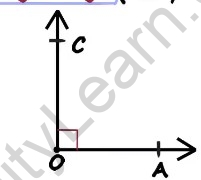Table of Contents
Table of Contents
- Types of Angles
- Right Angle
- Straight Angle
- Acute Angle
- Obtuse Angle
- Reflex Angle
- Summary
- What’s Next?
In our previous segment, we learned about the measurement of angles based on their direction of measurement. In this segment, we will learn about the different types of angles in geometry.
What are the Different types of angles?
There are two special types of angles:
Right angle
-
- A right angle is an angle that measures 90∘
- When two rays or two lines form a right angle, they are said to be perpendicular to each other.
- A right angle is marked using two lines.

Straight angle
-
- A straight angle is an angle that measures 180∘
Acute Angle
An acute angle is an angle that is less than 90 degrees. Acute angles are found in many different shapes, including right angles, acute triangles, and scalene triangles. Acute angles are often used in geometry to solve problems.
One of the most common uses of acute angles is in right triangles. A right triangle is a triangle that has one right angle. Right triangles are often used to find the length of the hypotenuse, which is the longest side of a right triangle. In a right triangle, the length of the hypotenuse can be found using the Pythagorean theorem.
Obtuse Angle
An obtuse angle is an angle greater than 90 degrees but less than 180 degrees. Obtuse angles are found in many places in the real world. Some examples are the corners of a room, the top of a staircase, and the opening of a door.
Obtuse angles can be tricky to work with, because they are not as straightforward as right angles or acute angles. However, with a little practice, they can be easily dealt with.
One thing to keep in mind when working with obtuse angles is that they can be split into two right angles. This can be helpful when trying to find a solution to a problem. For example, if you are trying to find the height of a triangle, and one of the angles is obtuse, you can split the angle in two and use the two right angles to find the height.
Reflex Angle
In geometry, the reflex angle is an angle that is greater than 180 degrees but less than 360 degrees. A reflex angle is created when two lines intersect and the angle between the lines is greater than 180 degrees. This angle can be measured in radians or degrees.
The reflex angle is important in geometry because it is used to calculate the size of certain angles. It can also be used to determine the shape of a triangle when two of its angles are known. In addition, the reflex angle is used to find the length of a side of a triangle when two other angles are known.
The reflex angle is also important in trigonometry. It is used to find the value of certain trigonometric functions. In addition, the reflex angle is used to find the height of a triangle when two other angles are known.





